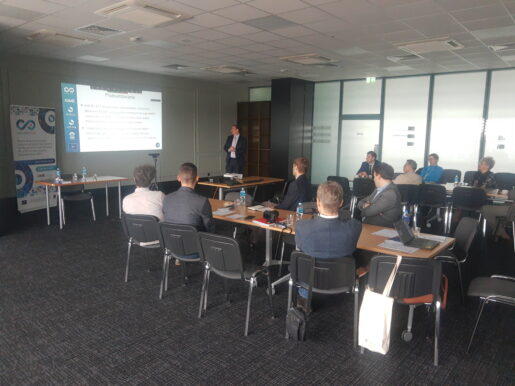
On May 18, 2023, the LIFE VIIEW 2050 project held an on line webinar entitled. “VIIEW 2050: Changing the scope of the EU ETS.” The recently published report by the Centre for Climate and Energy Analysis (CAKE), which examines the impact of the EU’s Fit for 55 package on the EU and Polish economy by 2050, was presented as a starting point for further discussion of possible options to support the implementation of climate policies by developing countries through fully-fledged and Paris Agreement-compliant national emissions trading schemes.
The meeting was attended by representatives of ministries, scientific institutes, companies and the Paris Committee on Capacity Building (PCCB).
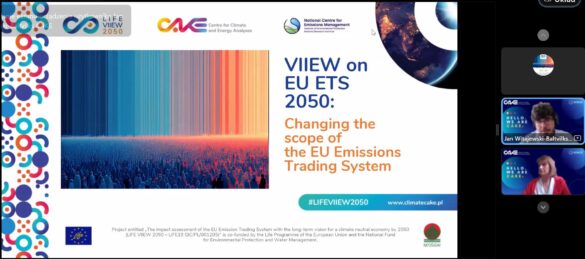
Marta Roslaniec, our expert from CAKE, serving as moderator, began the meeting with a brief introductory section on the goals of our latest LIFE VIIEW 2050 analysis and introductory questions to start the discussion relating to climate and energy policy goals.
In the main part of the meeting, Jan Witajewski-Baltvilks, our modeling expert from CAKE, presented the main assumptions, scenarios and results of CAKE’s latest analysis VIIEW on EU ETS 2050: Changing the scope of the EU ETS.
During his presentation, he outlined both the macroeconomic impacts for different scenarios, noting that the inclusion of new sectors in the EUETS will increase marginal abatement costs due to more expensive abatement options available in other sectors (currently not covered by the EU ETS). He also pointed out that Southern European countries would be the biggest beneficiaries of the inclusion of the buildings and transport (RTD) sectors in the EU ETS. In his presentation, he also presented the main lessons for the transport and agriculture sectors on the way to achieving climate neutrality. At the end of the meeting there was an interesting discussion with the participants on the assumptions made and the results.
The full analysis is available in English:
 VIIEW on EU ETS 2050: Changing the scope of the EU ETS (7.5 MiB, 1,597 hits)
VIIEW on EU ETS 2050: Changing the scope of the EU ETS (7.5 MiB, 1,597 hits)
We also invite you to join the Expert Platform to facilitate the exchange of information among experts by logging on to our website and LinkedIn channel.
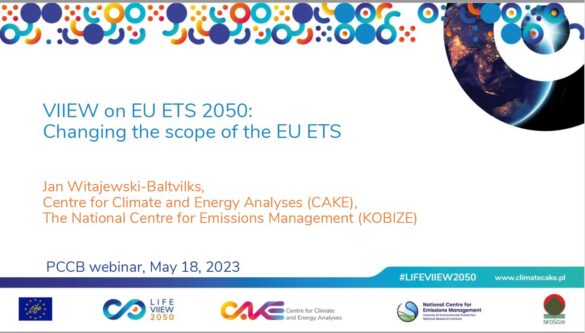
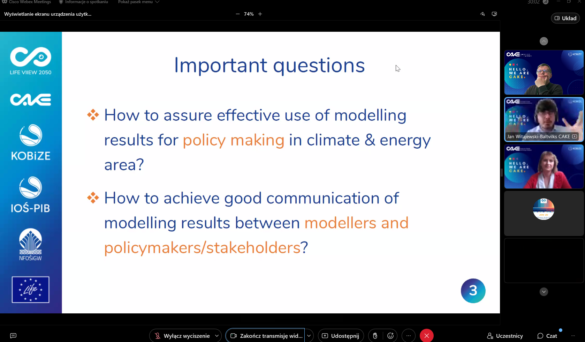

On the 3 May Robert Jeszke, CEO of CAKE participated in the EUI Climate Week at organized by European University Institute and School of Transnational Governance. Robert Jeszke took part in the panel discussion focused on the Carbon Markets in the session: “What Next for EU Climate Policy?”.
The legislation resulting from the European Green Deal is being finalised. This is a major achievement, but the new context of the war in Ukraine has changed the boundary conditions dramatically, particularly for the EU. In the meantime, the US has adopted its IRA. What can we expect for the remainder of the decade? How to maintain a solid industrial base on the European continent?
Does the EU need a new geopolitical strategy on energy and industry? How should the agenda towards 2040 be shaped in preparing the EU to reach ‘netzero’ greenhouse gas emissions in 2050? Might some Member State be expected to over-achieve on ‘net-zero’ so that others can continue to emit? These were the key questions and doubts that came up during the discussion.
Panel participants were:
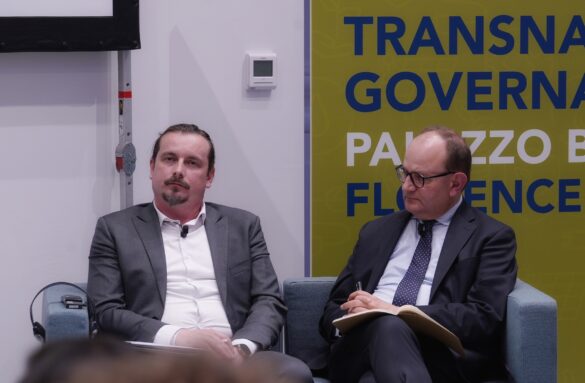 Robert Jeszke presented the main conclusions from the latest CAKE analysis. If the EU ETS is to remain a market-based instrument and continue to be the central pillar of the EU’s climate policy, it will inevitably need to be reformed further and extended to more sectors of the economy. Extending the EU ETS to cover new sectors would mitigate the risk of its collapse and ensure that the system would continue to serve as the key measure to reduce emissions in the most efficient way. Merging the current EUETS with the ETS2 for buildings and transport can bring big winners and big loosers. Robert Jeszke emphasized that due to CAKE simulations in case if the two schemes function separately, the price of emission allowances in the BRT system is very large in the long run. This situation would generate large costs for regions with high deficit of allowances in BRT, who must purchase allowances from the other regions. If we merge EUETS and ETS2, the marginal costs in ETS2 will be radically lower. Main beneficiaries of merging EUETS and ETS2 in the long-run would be South-East Europe, Central Europe, Northern Europe and Poland. Reaching netzero target in EU in 2050 would be practically impossible without a wide range of carbonremoval, including both technologies such as CCS/CCU as well as negative emissions from BECCS and AFOLU.
Robert Jeszke presented the main conclusions from the latest CAKE analysis. If the EU ETS is to remain a market-based instrument and continue to be the central pillar of the EU’s climate policy, it will inevitably need to be reformed further and extended to more sectors of the economy. Extending the EU ETS to cover new sectors would mitigate the risk of its collapse and ensure that the system would continue to serve as the key measure to reduce emissions in the most efficient way. Merging the current EUETS with the ETS2 for buildings and transport can bring big winners and big loosers. Robert Jeszke emphasized that due to CAKE simulations in case if the two schemes function separately, the price of emission allowances in the BRT system is very large in the long run. This situation would generate large costs for regions with high deficit of allowances in BRT, who must purchase allowances from the other regions. If we merge EUETS and ETS2, the marginal costs in ETS2 will be radically lower. Main beneficiaries of merging EUETS and ETS2 in the long-run would be South-East Europe, Central Europe, Northern Europe and Poland. Reaching netzero target in EU in 2050 would be practically impossible without a wide range of carbonremoval, including both technologies such as CCS/CCU as well as negative emissions from BECCS and AFOLU.
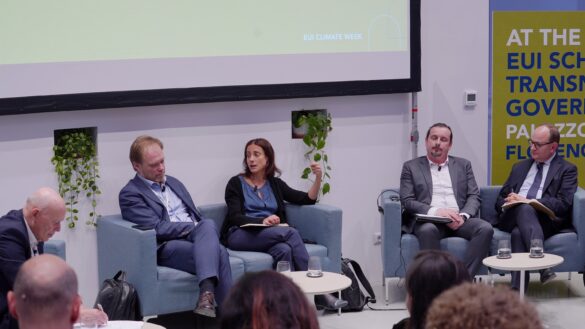 The electric power sector plays a key role in achieving the netzero goal in 2050, mainly due to its high emission reduction potential. Without negative emissions from the energy sector, it is practically impossible to achieve a zero-emission economy. Europe does not have enough RES capacity potential to meet the demand for electricity and clean hydrogen without nuclear power or without import of energy. There is need to create a system to develop green hydrogen using RES and nuclear sources in the EU structures. We should talk also about post 2050 period. The mechanisms and technology must go beyond this year to ensure Europe’s emission neutrality. That is why the energy sector plays such an important role.
The electric power sector plays a key role in achieving the netzero goal in 2050, mainly due to its high emission reduction potential. Without negative emissions from the energy sector, it is practically impossible to achieve a zero-emission economy. Europe does not have enough RES capacity potential to meet the demand for electricity and clean hydrogen without nuclear power or without import of energy. There is need to create a system to develop green hydrogen using RES and nuclear sources in the EU structures. We should talk also about post 2050 period. The mechanisms and technology must go beyond this year to ensure Europe’s emission neutrality. That is why the energy sector plays such an important role.
Recording form the meeting is available here: LINK

You are welcome to join the LIFE VIIEW 2050 webinar on “Changing the scope of the EU Emissions Trading Scheme” to be held online on May 18th, 2023 at 2:00 – 3:30 pm (CET).
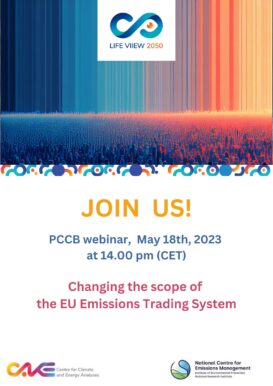
The recent report of the Centre for Climate and Energy Analyses (CAKE) that explores the impacts of the EU Fit for 55 package on the EU and Poland economy until 2050 will be presented as a background for further discussing options for developing countries that are looking at supporting the implementation of their climate policies through fully-fledged and Paris Agreement-compatible domestic carbon markets, with a view to the future linking for a truly global impact.
Please register HERE, so you will be provided with the link to the webinar.
AGENDA: LINK
Full analysis is available here:
 VIIEW on EU ETS 2050: Changing the scope of the EU ETS (7.5 MiB, 1,597 hits)
VIIEW on EU ETS 2050: Changing the scope of the EU ETS (7.5 MiB, 1,597 hits)
We also invite you to join us at Platform of Experts to share knowledge, facilitate information exchange among carbon markets experts, and provide space for wider dissemination of the carbon pricing expertise. through: website is here LINK (https://climatecake.ios.edu.pl/life-viiew-2050-platform/?lang=en ) and on LinkedIn!
Do not hesitate to contact us if you would have any further questions: cake@kobize.pl

On the 26th April 2023 the 2nd LIFE VIIEW 2050 Platform of Experts meeting was held. During the meeting the analysis “VIIEW on EUETS 2050: Changing the scope of the EU ETS” was presented.
 VIIEW on EU ETS 2050: Changing the scope of the EU ETS (7.5 MiB, 1,597 hits)
VIIEW on EU ETS 2050: Changing the scope of the EU ETS (7.5 MiB, 1,597 hits)
During the meeting our experts presented main assumptions, scenarios & outcomes of our new analysis.
Robert Jeszke, Head of CAKE began with the short introduction of the main LIFEVIIEW2050 project goals, and the objectives of the analysis which presents different options of the transition towards climateneutrality in line with the goals set in the European Green Deal.
Jakub Boratyński, CGE modelling expert presented the models applied, analytical assumptions, different model scenarios and the macroeconomic results concerning the potential extension of the EUETS to the new sectors such as transport and buildings.
In the second part of the meeting CAKE experts briefly presented different main sectoral outcomes of the analysis (here are just short briefs):
Igor Tatarewicz, eenergy modelling expert on the future energy mix, highlight that variable RES and hydropower would be responsible for 80% generation of electricity mix.
Artur Gorzałczyński, transport modelling expert indicated that as result of the inclusion of the transport sector in the BRT ETS system, the costs of using combustion vehicles would increase.
Paweł Kobus, agriculture modelling expert underlined that taxation of GHG emissions in EU agriculture significantly reduces emissions but at the cost of losing competitiveness of EU agricultural production.
Thank you for insightfull discussion and particpation. If you want to know more details please look into our analysis!
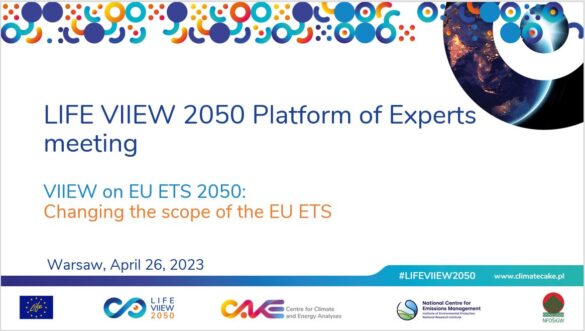

On 12 April 2023, a meeting for the public administration, was held in a stationary and online format, during which the results of the first study ‘VIIEW on EU ETS 2050: Changing the scope of the EU Emissions Trading System‘, prepared within the framework of the LIFE VIIEW 2050 project was presented. The meeting was attended by representatives of the KOBIZE/IOŚ-PIB management, CAKE experts from the LIFE VIIEW 2050 project and invited guests representing various governmental authorities.
 VIIEW on EU ETS 2050: Changing the scope of the EU ETS (7.5 MiB, 1,597 hits)
VIIEW on EU ETS 2050: Changing the scope of the EU ETS (7.5 MiB, 1,597 hits)
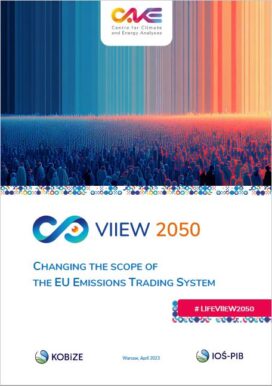 During the meeting, Robert Jeszke, Head of CAKE and Project Coordinator of the LIFE VIIEW 2050 project, gave a brief introduction to the subject of the objectives and scope of the analysis carried out and briefly discussed its main elements. Then, CAKE experts from the LIFE VIIEW 2050 project team presented the main elements and detailed conclusions resulted form the prepared LIFE VIIEW analysis.
During the meeting, Robert Jeszke, Head of CAKE and Project Coordinator of the LIFE VIIEW 2050 project, gave a brief introduction to the subject of the objectives and scope of the analysis carried out and briefly discussed its main elements. Then, CAKE experts from the LIFE VIIEW 2050 project team presented the main elements and detailed conclusions resulted form the prepared LIFE VIIEW analysis.
Maciej Pyrka, CGE modelling expert, presented information on the development of modelling tools and sectoral models that were used in the VIIEW on the EU ETS 2050 analysis, as well as informed about the scenarios used . He emphasised that the results of analysis of the feasibility of expanding the ETS show, in particular, that the inclusion of new sectors in emissions trading will be associated with an increase in marginal abatement costs, mainly due to more expensive abatement options available in sectors not currently covered by the ETS (non-ETS).
Igor Tatarewicz, energy modelling expert, presented the main conclusions in the context of the future of the energy sector in the 2050 perspective. He emphasised that the different scenarios for the inclusion of non-ETS sectors in the ETS have no significant impact on the rate of transformation of the energy sector, as already in the Fit55 scenario fossil fuels are almost completely replaced by low- and zero-carbon technologies.
Artur Gorzałczyński, transport sector modelling expert presented the results of an analysis relating to the future of the passenger and freight transport sector in the 2030 and 2050 perspectives. One of the main findings of the analysis is the great potential for the rapid replacement of diesel buses with electric and hydrogen equivalents, a process which has already begun in many European cities, including Poland. This process is beneficial for the Polish economy, as Poland is the leading producer of electric buses in the EU.
Adam Wąs, agricultural modelling expert, pointed out that a significant reduction in greenhouse gas emissions in the agricultural sector translates into production volumes through a serious reduction in the value of food production, which is particularly evident in the case of Poland.
